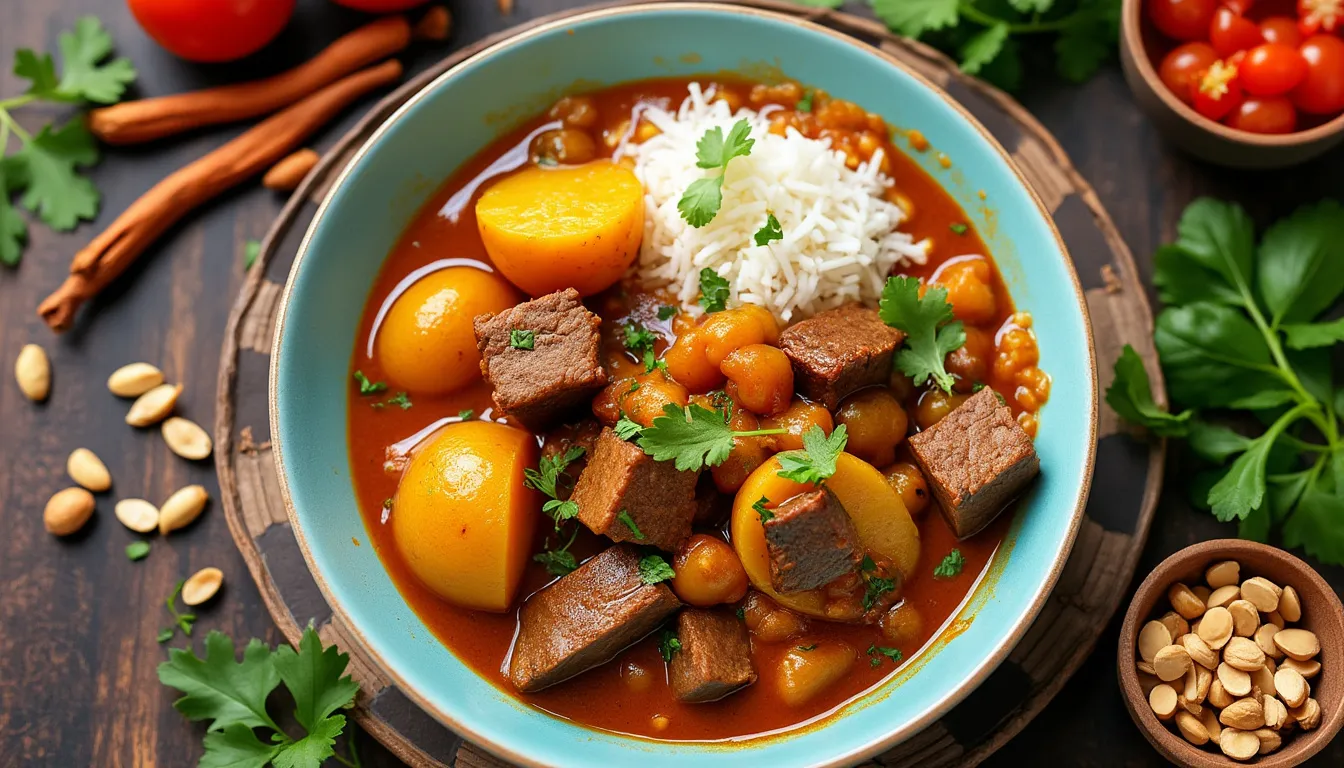Discover the Rich Flavors of Massaman Curry
Welcome to a delectable journey through the rich and aromatic world of Massaman curry. This extraordinary dish, renowned for its harmonious blend of spices and flavors, holds a special place in the rich tapestry of Southeast Asian cuisine. With its roots deeply embedded in Thai and Malay culinary traditions, Massaman curry offers a unique taste experience that tantalizes the taste buds and warms the soul. Whether you are a seasoned chef or a curious food enthusiast, this guide will introduce you to the history, ingredients, and techniques that make Massaman curry a beloved dish worldwide.
A Brief History of Massaman Curry
Massaman curry, often referred to as the king of curries, has a fascinating history that reflects the cultural exchanges and influences between Thailand and Malaysia. It boasts a rich heritage that dates back centuries, evolving with diverse ingredients and cooking methods influenced by both Thai and Malay cuisines. Understanding its origins and cultural significance can provide a deeper appreciation for the intricate flavors that define this dish.
The Unique Ingredients that Define Massaman Curry
The secret to Massaman curry’s distinctive flavor lies in its unique blend of ingredients. Traditional spices like cinnamon, cardamom, and cloves not only contribute to its robust taste but also offer various health benefits. Alongside these spices, aromatic herbs and creamy coconut milk create a luscious base that complements the essential proteins and vegetables typical in Massaman curry recipes. Each ingredient plays a crucial role, making this dish a true culinary masterpiece.
Crafting the Perfect Massaman Curry at Home
Creating an authentic Massaman curry at home might seem daunting, but with the right guidance, it becomes a rewarding culinary adventure. We’ll provide you with step-by-step cooking instructions that ensure an authentic taste, along with tips to customize spice levels and ingredients to suit your preferences. Additionally, learn how to pair Massaman curry with complementary side dishes to create a complete and satisfying meal experience, right in your own kitchen.
A Brief History of Massaman Curry
Origins and Cultural Significance
Massaman curry, a dish well-loved by many, boasts a rich history intertwined with the culinary traditions of Thailand and beyond. The word Massaman itself is a derivation from the term Mussulman, an archaic way of indicating a Muslim individual. This historical clue points towards the dish’s origins, which trace back to the culinary exchanges between Persian traders and the people of Thailand during the 17th century. These traders introduced a range of spices that were not native to Southeast Asia, such as cardamom, cloves, and cumin, forever influencing Thai cuisine. As a result, Massaman curry is often seen as a fusion of Middle Eastern, Indian, and Southeast Asian flavors, making it a unique and beloved addition to Thai food culture.
The cultural significance of Massaman curry extends beyond its captivating flavor. It frequently appears on the menus of Thai households during special occasions and gatherings, symbolizing a fusion of diverse cultural influences and the warmth of a communal meal. Over the years, Massaman curry has also gained international fame, becoming a symbol of Thailand’s gastronomic wealth and attracting food enthusiasts from around the world.
Evolution of Ingredients and Cooking Methods
The ingredients and cooking methods of Massaman curry have seen considerable changes over the centuries. Initially, the curry incorporated locally available elements and reflected the simplicity of its time. However, as trade routes expanded and culinary techniques advanced, the recipe began to evolve. Innovators in Thai cuisine started incorporating more intricate and flavorful ingredients, borrowing techniques from neighboring nations and perfecting the dish though generations.
A traditional Massaman curry base includes ingredients such as coconut milk, potatoes, onions, peanuts, and tender chunks of meat – often beef or chicken. The complexity of its flavor comes from the intricate balance of sweetness, heat, and savory elements derived from spices like cinnamon, nutmeg, and bay leaves. Today, Massaman curry recipes continue to evolve, with chefs experimenting with new ingredients, alternative proteins, and vegetarian versions, all the while preserving the core essence of the dish.
Influence of Thai and Malay Cuisines
Massaman curry stands out as a testament to the rich cultural and culinary exchanges between Thailand and its neighboring regions, particularly Malaysia. The Malay influence is evident in the use of certain spices and cooking techniques. For example, the Malaysian penchant for rich, coconut-based sauces can be seen in the creamy texture and depth of flavor that defines a well-made Massaman curry.
The Thai influence, on the other hand, is visible in the meticulous balance of flavors that Thai cuisine is renowned for. Thai culinary principles emphasize the harmony of sweet, salty, sour, and spicy elements, which is masterfully achieved in Massaman curry. Whether through the sweet notes of coconut milk and palm sugar, the salty punch of fish sauce, or the slight tang from tamarind paste, Thai culinary practices have honed Massaman curry into a dish with an exquisite taste profile.
Moreover, Thai cuisine’s focus on fresh ingredients and vibrant flavors is evident in the use of fresh herbs and spices, which add a bright and aromatic quality to the curry. These culinary traditions have collectively contributed to the reputation of Massaman curry as a dish that not only tantalizes the taste buds but also encapsulates the rich heritage of Southeast Asian cooking.
The Unique Ingredients that Define Massaman Curry
Traditional Spices and Their Health Benefits
One of the most compelling aspects of Massaman curry is its unique blend of traditional spices. These spices not only contribute to its rich and complex flavor but also offer numerous health benefits. Key spices in Massaman curry include:
- Coriander: Known for its anti-inflammatory properties, coriander is believed to aid digestion and boost heart health.
- Cumin: Rich in iron, cumin supports metabolism and helps in the management of diabetes.
- Cinnamon: With its antioxidant and anti-inflammatory properties, cinnamon is beneficial for lowering blood sugar levels.
- Cardamom: Often used for its digestive benefits, cardamom is also known to improve oral health.
- Cloves: High in antioxidants, cloves help in reducing oxidative stress and boosting immunity.
These spices form the backbone of the Massaman curry paste, which can be either homemade or purchased from specialty stores. The harmonious blend of these spices creates a unique flavor profile that sets Massaman curry apart from other Thai curries.
The Role of Aromatic Herbs and Coconut Milk
Aromatic herbs and coconut milk play a crucial role in providing Massaman curry with its distinct aroma and creamy texture. Essential herbs include:
- Lemongrass: This herb adds a citrusy note that brightens the dish, complementing the rich and spicy flavors.
- Kaffir Lime Leaves: These leaves lend a zesty, tangy aroma that enhances the overall flavor profile.
- Galangal: Often compared to ginger, galangal provides a peppery and slightly sweet flavor, adding depth to the curry.
Coconut milk, another key ingredient, imparts a luxurious and creamy texture to the curry, balancing the intensity of the spices.
Essential Proteins and Vegetables in Massaman Curry Recipes
The protein and vegetable components in Massaman curry can vary, making it a versatile dish that caters to different dietary preferences. Traditional protein choices include:
- Beef: Slow-cooked beef is a popular choice, allowing the meat to absorb the curry’s rich flavors.
- Chicken: A leaner option, chicken pairs well with the curry’s spices and creamy coconut milk.
- Lamb: Though less common, lamb adds a unique flavor that works beautifully with Massaman curry’s spices.
For those who prefer a vegetarian option, tofu can be used as a protein source. Alongside these proteins, a variety of vegetables can be incorporated to enhance the flavor and nutritional value of the dish. Common choices include:
- Potatoes: These starchy vegetables absorb the curry’s flavors and contribute to its hearty texture.
- Carrots: Sweet and colorful, carrots add both flavor and visual appeal to the dish.
- Onions: Their sweet, caramelized flavor melds well with the spices and herbs.
- Peanuts: Often sprinkled on top, peanuts add a delightful crunch and additional protein.
The combination of these ingredients not only defines the unique taste of Massaman curry but also makes it a nutritionally balanced meal, rich in protein, fiber, and essential vitamins.
Crafting the Perfect Massaman Curry at Home
Step-by-Step Cooking Instructions for Authentic Taste
Creating an authentic Massaman curry at home might seem daunting, but with the right ingredients and a bit of patience, you can replicate the rich flavors of this beloved Thai dish. Here is a comprehensive guide to help you craft an exquisite Massaman curry that will impress your family and friends.
Ingredients:
- 2 tablespoons of Massaman curry paste
- 1 can (400ml) of coconut milk
- 500 grams of beef, chicken, or tofu
- 2-3 potatoes, peeled and diced
- 1 onion, finely chopped
- 3 cloves of garlic, minced
- 1 cinnamon stick
- 3-4 cardamom pods
- 1-2 bay leaves
- 1 tablespoon of fish sauce
- 2 tablespoons of tamarind paste
- 1 tablespoon of palm sugar or brown sugar
- Peanuts or cashews for garnish
- Fresh cilantro for garnish
- Salt to taste
Instructions:
- Prepare the Ingredients: Start by chopping the potatoes and onion, and mincing the garlic. Cut the protein into bite-sized pieces to ensure even cooking. Use tofu if you prefer a vegetarian option.
- Sauté the Aromatics: Heat a large pot or Dutch oven over medium heat. Add a small amount of coconut milk and bring to a simmer. Stir in the Massaman curry paste, garlic, cinnamon stick, cardamom pods, and bay leaves. Cook for 2-3 minutes, allowing the spices to release their aromas.
- Add the Protein: Incorporate the beef, chicken, or tofu into the pot, ensuring they are well-coated with the curry paste mixture. Sear the protein on all sides until browned.
- Simmer with Coconut Milk: Slowly add the remaining coconut milk to the pot. Bring the mixture to a gentle boil, then reduce the heat to low. Let it simmer for about 20 minutes, allowing the flavors to meld together.
- Add Vegetables and Seasonings: Stir in the diced potatoes, chopped onion, fish sauce, tamarind paste, and palm sugar. Continue simmering for another 20-25 minutes or until the potatoes are tender and the sauce has thickened.
- Season to Taste: Taste the curry and adjust the seasoning with salt, fish sauce, or sugar as needed. Remove the cinnamon stick and bay leaves before serving.
- Final Touches: Garnish the curry with freshly chopped cilantro and a handful of peanuts or cashews for added texture and flavor. Serve hot with steamed jasmine rice or roti.
Tips for Customizing Spice Levels and Ingredients
One of the beauties of Massaman curry is its versatility. Here are some expert tips to tailor the dish to your taste preferences and dietary needs:
- Adjusting Spice Levels: If you prefer a milder curry, use less Massaman curry paste or choose a brand known for being less spicy. For more heat, add fresh Thai chilies, red chili flakes, or a touch more curry paste.
- Protein Alternatives: While traditional Massaman curry often includes beef or chicken, you can easily substitute with lamb, duck, or even shrimp for a seafood twist. Vegetarians can add a mix of firm tofu and hearty vegetables like eggplant or mushrooms.
- Vegetable Variations: Feel free to get creative with the vegetables in your curry. Sweet potatoes, carrots, and bell peppers can add both nutrition and a burst of color.
- Sweetness and Tanginess: Alter the balance of sweetness and tanginess by experimenting with the amounts of palm sugar and tamarind paste. Some recipes also incorporate pineapple for a fruity touch.
Pairing Massaman Curry with Sides for a Complete Meal Experience
A great Massaman curry deserves equally delightful sides. Here are some classic and innovative pairings to complete your meal:
- Steamed Jasmine Rice: A staple in Thai cuisine, jasmine rice’s aromatic qualities complement the rich, creamy curry perfectly.
- Roti: This flaky Indian bread is excellent for soaking up the flavorful curry sauce. It adds a unique textural contrast to the meal.
- Pickled Vegetables: A side of lightly pickled carrots, cucumbers, and radishes can offer a refreshing contrast to the rich, creamy curry.
- Thai Cucumber Salad: For a cooling side, prepare a quick Thai cucumber salad with sliced cucumbers, red onion, chili, and a dressing of vinegar, sugar, and salt.
- Spicy Thai Papaya Salad (Som Tum): If you’re looking to add an extra kick to your meal, this tangy and spicy salad can provide an exciting counterbalance to the mellow Massaman curry.
With these instructions and tips, you’re well on your way to mastering the art of making Massaman curry at home. Enjoy the process and savor the rich, complex flavors that this iconic Thai dish has to offer.
Conclusion
Massaman curry not only offers a delightful culinary journey but also serves as a testament to the rich and complex history of Southeast Asian cuisine. By understanding its origins and cultural significance, appreciating its unique blend of spices and ingredients, and mastering the art of crafting it at home, you can fully embrace the rich flavors of massaman curry. This dish, with its harmonious blend of Thai and Malay influences, aromatic herbs, and creamy coconut milk, provides both a feast for your taste buds and a glimpse into the diverse traditions that define it.
Whether you are a seasoned cook or a novice in the kitchen, creating your own massaman curry allows you to customize it to your personal taste, ensuring a meal that is both satisfying and nourishing. Pair it with traditional sides, and you have an unforgettable dining experience that brings the warmth and richness of Thai flavors right to your table.
So, embark on this culinary adventure, and let the magic of massaman curry transform your meals into something extraordinary. With every ingredient and every bite, you’ll discover a deeper appreciation for one of Thailand’s most treasured dishes.







